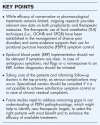Efficacy of therapies for post dural puncture headache
- PMID: 38372283
- PMCID: PMC11062605
- DOI: 10.1097/ACO.0000000000001361
Efficacy of therapies for post dural puncture headache
Abstract
Purpose of review: Clinical management of postdural puncture headache (PDPH) remains an interdisciplinary challenge with significant impact on both morbidity and quality of life. This review aims to give an overview of the most recent literature on prophylactic and therapeutic measures and to discuss novel findings with regard to currently published consensus practice guideline recommendations.
Recent findings: Although current evidence does not support a recommendation of any specific prophylactic measure, new data is available on the use of intrathecal catheters to prevent PDPH and/or to avoid invasive procedures. In case of disabling or refractory symptoms despite conservative treatments, the epidural blood patch (EBP) remains the therapeutic gold standard and its use should not be delayed in the absence of contraindications. However, recent clinical studies and meta-analyses provide additional findings on the therapeutic use of local anesthetics as potential noninvasive alternatives for early symptom control.
Summary: There is continuing research focusing on both prophylactic and therapeutic measures offering promising data on potential alternatives to invasive procedures, although there is currently no treatment option that comes close to the effectiveness of an EBP. A better understanding of PDPH pathophysiology is not only necessary to identify new therapeutic targets, but also to recognize patients who benefit most from current treatments, as this might enhance their therapeutic efficacy.
Copyright © 2024 The Author(s). Published by Wolters Kluwer Health, Inc.
Conflict of interest statement
Similar articles
-
A Comprehensive Update on the Treatment and Management of Postdural Puncture Headache.Curr Pain Headache Rep. 2020 Apr 22;24(6):24. doi: 10.1007/s11916-020-00860-0. Curr Pain Headache Rep. 2020. PMID: 32323013 Review.
-
Topical Sphenopalatine Ganglion Block Compared With Epidural Blood Patch for Postdural Puncture Headache Management in Postpartum Patients: A Retrospective Review.Reg Anesth Pain Med. 2018 Nov;43(8):880-884. doi: 10.1097/AAP.0000000000000840. Reg Anesth Pain Med. 2018. PMID: 30063655
-
The management of accidental dural puncture and postdural puncture headache: a North American survey.J Clin Anesth. 2011 Aug;23(5):349-60. doi: 10.1016/j.jclinane.2011.04.003. Epub 2011 Jun 22. J Clin Anesth. 2011. PMID: 21696932
-
Management of Post Dural Puncture Headache During Spinal Cord Stimulation Trials: A Review of Current Literature.Curr Pain Headache Rep. 2024 Nov;28(11):1073-1078. doi: 10.1007/s11916-024-01289-5. Epub 2024 Jun 25. Curr Pain Headache Rep. 2024. PMID: 38916716 Review.
-
Unusual presentation of postdural puncture headache requiring repeat epidural blood patch in a 4-year-old child.Paediatr Anaesth. 2014 May;24(5):541-3. doi: 10.1111/pan.12330. Epub 2013 Dec 24. Paediatr Anaesth. 2014. PMID: 24372745
Cited by
-
The quality and reliability of YouTube and TikTok videos on epidural blood patch: A cross-sectional analysis.Medicine (Baltimore). 2025 Aug 1;104(31):e43628. doi: 10.1097/MD.0000000000043628. Medicine (Baltimore). 2025. PMID: 40760581 Free PMC article.
-
Prophylactic Fibrin Glue Application for Immediate Management of Dural Puncture during Spinal Cord Stimulation Lead Placement: a Simple and Effective Technique.Curr Pain Headache Rep. 2025 Mar 25;29(1):70. doi: 10.1007/s11916-025-01381-4. Curr Pain Headache Rep. 2025. PMID: 40131573 Review.
-
Assessment of YouTube videos on post-dural puncture headache: a cross-sectional study.PeerJ. 2025 Mar 19;13:e19151. doi: 10.7717/peerj.19151. eCollection 2025. PeerJ. 2025. PMID: 40124605 Free PMC article.
-
Efficacy and Safety of Prophylactic Intrathecal or Epidural Normal Saline for Preventing Post-Dural Puncture Headache After Dural Puncture: A Meta-Analysis and Systematic Review.J Pain Res. 2025 Feb 26;18:915-927. doi: 10.2147/JPR.S494237. eCollection 2025. J Pain Res. 2025. PMID: 40027214 Free PMC article. Review.
-
[NAPOK: national register on analysis of (non)invasive treatment procedures for postdural puncture headache-Protocol publication].Anaesthesiologie. 2025 Mar;74(3):156-158. doi: 10.1007/s00101-025-01512-x. Epub 2025 Feb 11. Anaesthesiologie. 2025. PMID: 39934381 Free PMC article. German. No abstract available.
References
-
- Headache Classification Committee of the International Headache Society (I). The International Classification of Headache Disorders, 3rd edition. Cephalalgia. 2018;38:1–211. - PubMed
-
- Siegler BH, Oehler B, Kranke P, Weigand MA. Postdural puncture headache in obstetrics: pathogenesis, diagnostics and treatment. Die Anaesthesiologie 2022; 71:646–660. - PubMed
-
- D’Angelo R, Smiley RM, Riley ET, Segal S. Serious complications related to obstetric anesthesia: the serious complication repository project of the Society for Obstetric Anesthesia and Perinatology. Anesthesiology 2014; 120:1505–1512. - PubMed
-
- Sprigge JS, Harper SJ. Accidental dural puncture and post dural puncture headache in obstetric anaesthesia: presentation and management: a 23-year survey in a district general hospital. Anaesthesia 2008; 63:36–43. - PubMed
Publication types
MeSH terms
Substances
LinkOut - more resources
Full Text Sources
Research Materials


